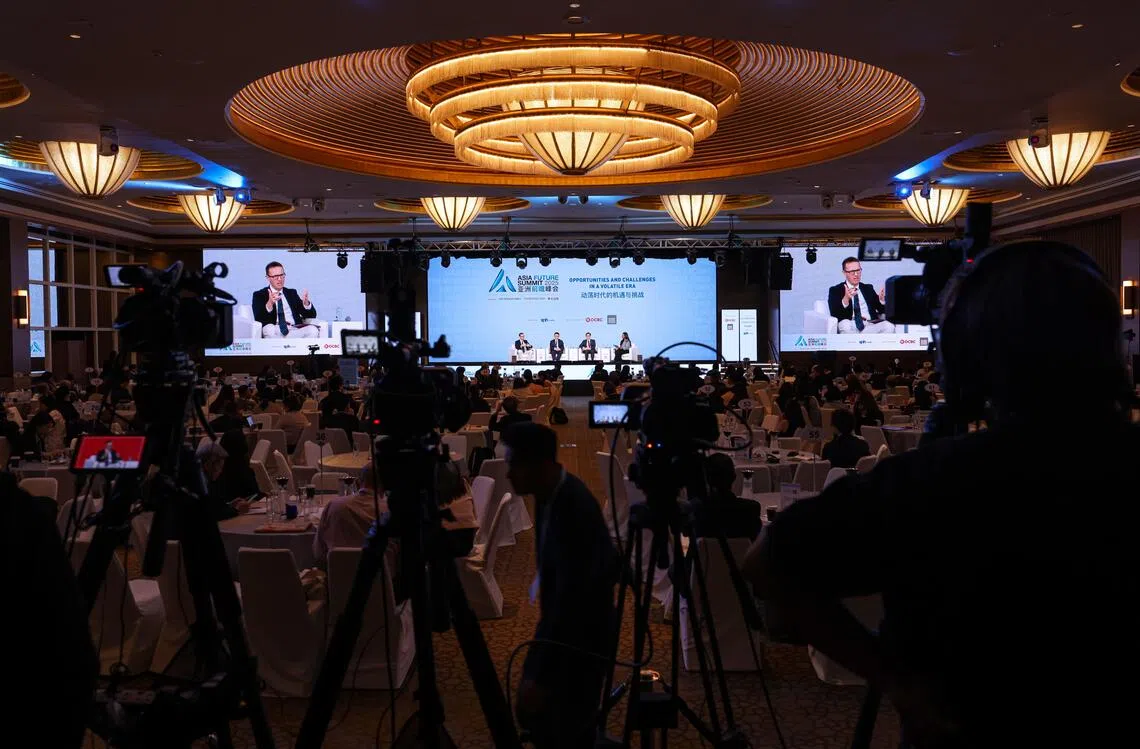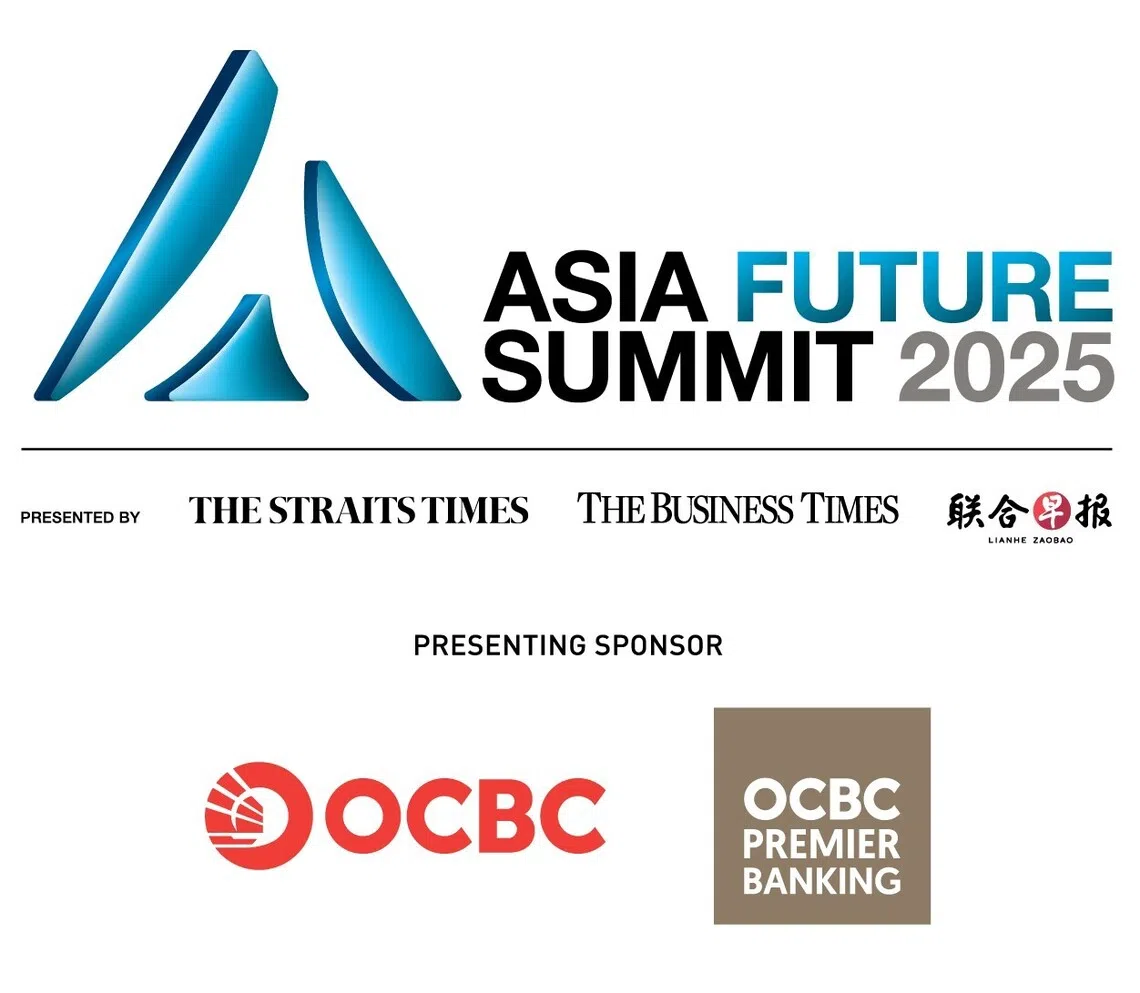The new Asian playbook: Industry leaders weigh in on competing in AI and green
Artificial intelligence creates huge value, but the region’s challenge lies in boosting its own relevance among the larger players

[SINGAPORE] The blueprint for businesses to command Asia’s growing sway amid a volatile world lies in carving out a position in the artificial intelligence (AI) revolution and putting money where the green is.
These were the insights raised by top leaders from a global cloud giant, a tech behemoth and one of South-east Asia’s largest lenders on the second day of the Asia Future Summit on Thursday (Oct 9).
The premier thought leadership conference is jointly presented by SPH Media’s flagship titles The Business Times, The Straits Times and Lianhe Zaobao, with OCBC as the presenting sponsor.
Headlining a panel on the opportunities and challenges in a volatile era were OCBC’s deputy chief executive Tan Teck Long; Amazon Web Services’ managing director of Asean, Jeff Johnson; and Sea’s chief operating officer and co-founder, Ye Gang.
The hour-long session dived into several major shifts shaping the future: how the AI needle can turn from hype to hard results, and how affordable, reliable power now decides where platforms grow, where factories land and where investors place their bets.
BT deputy news editor Anita Gabriel, who moderated the session, kicked things off with a question on the single biggest opportunity and hardest challenge the trio see in Asia today.
The panel concurred that AI was the answer to both.
“AI is a huge value creator,” said Ye. “It’s going to improve efficiency, (spur a) huge increase in productivity and create many industries that previously weren’t possible.”
Yet, the entrepreneur noted, therein lies the challenge for Asia: how businesses can make themselves relevant and jockey for position among larger players, such as the US, which sits on top of the AI value chain.
SEE ALSO
“Asia is, of course, a big consumer market with huge demand, but how do we go beyond just being a market and become a legitimate player in this new revolution to come?”
With the world at the beginning of what he described as the inflexion point of using AI, OCBC’s Tan said the test lies in financing.
“AI requires a lot of investment. It is capex-heavy and energy-intensive. Some countries in Asia may not have the ability to leverage AI and may fall behind,” said the executive, who double-hats as the bank’s head of global wholesale banking and will take over the top job on Jan 1 next year.
As far as AWS’ Johnson is concerned, the opportunity lies in the possibility of truly democratising access to AI, which enables people to compress learning curves that have often held them back in their jobs.
“(Organisations are) now beginning to think how they can truly become AI-native and imagine their business, their processes from the ground up, from a blank sheet of paper, and think how to build that with AI tools,” he said.
But the challenge lies in shifting the way companies think and their organisational cultures, he added.

Asked to hazard a guess on how long businesses may take to even more broadly adopt AI, Johnson said he believes the world is at a tipping point of seeing its value unlocked.
“We’re seeing, this year, a shift from experiments in single-use cases to core functions (in) sales and marketing, and seeing how we can reimagine that from an AI-native perspective,” he said, adding that he has observed the same in the areas of software development and banking.
Ye put the figure at about a decade or so, remarking that promises made and advances discussed in the science-fiction world today could eventually be realised one way or another in various forms.
Addressing a question on how investors turn swings into opportunities, Tan acknowledged that while capital flows tend to be more volatile in the financial market, things are different in the fiscal world, where investment flows are more stable.
“We find that investors are still very interested in investing in the region and their investment thesis tends to be longer-term,” he noted.
This would then play well when it comes to financing Asia’s clean-energy transition.
“Investors always look for something profitable, and energy projects generally (have) a long time horizon,” Tan pointed out. “As long as (the investments are) structured correctly, they are quite happy to do it.”
Instead, the constraints tend to show up in the regulatory environments or the support from the countries promoting these projects, he added.
The panel wrapped up with a series of rapid-fire questions, the first of which made the trio pick one of three bottlenecks – regulation, energy or talent – to remove overnight.
AWS’ Johnson and Sea’s Ye singled out talent, while OCBC’s Tan pointed to energy, saying: “People are important, (but) what’s really commercially important for Asean is a common, upgraded energy grid.”
The two-day Asia Future Summit was held at The Ritz-Carlton, Millenia Singapore. For its fourth edition this year, the theme was “Navigating a Fractured World”.
For more information on the Asia Future Summit, visit businesstimes.com.sg/asia-future-summit

Decoding Asia newsletter: your guide to navigating Asia in a new global order. Sign up here to get Decoding Asia newsletter. Delivered to your inbox. Free.
Copyright SPH Media. All rights reserved.





